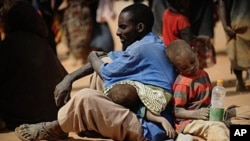A study by a coalition of U.N. and private aid agencies finds protection programs for children caught in conflict and natural disasters are, after education, the most under-funded operations. The study, commissioned by the Global Protection Cluster’s Child Protection Working Group, says lack of protection programs has devastating consequences for refugee and displaced children.
Last year, about 250,000 people were affected by natural disasters. Half of the victims were children. Conflict also claims hundreds of thousands of victims every year. And, it is the children who suffer the most.
And yet, during times of crisis, when children most need help from the international community, they are not getting it.
Such were the findings of a recently published study conducted by the non-profit organization Save the Children.
The study looked at funding levels for child protection in the years 2008 and 2009. Among other things, it found that, despite significant requests, only 47 percent of estimated total requirements were funded in 2008 and only 32 percent was funded in 2009.
The study also found that while humanitarian funding overall grew during the period, the same consistent trend was not seen in the child protection sector.
Rashid Khalikov, the Director of the Office for the Coordination of Humanitarian Affairs in Geneva, says funding levels for areas of conflict in Africa indicate the severity of funding deficiencies.
“Child protection issues very often are parts of larger protection issues when it comes to emergencies like the ones in the Democratic Republic of Congo, Somalia and Sudan. And, one could see that in the Democratic Republic of Congo, it is 22 percent, Somalia nine percent, and Sudan 12 percent of funding. I would like to tell you that Libya child protection activities are not funded at all. Not a single penny came for funding of that area and that is very important area,” said Khalikov.
Deputy Director of the U.N. Children’s Fund, Dermot Carty calls this disconcerting, but not surprising. He says child protection activities in emergencies are under-funded because they are not as visible as operations that provide clean water and sanitation or those that tackle cholera or other disease outbreaks.
He says governments like to see what they are getting for their money and showing how children are being protected from abuse and exploitation is very difficult to do.
Unfortunately, he says the money governments give to the United Nations tends to be earmarked for specific programs and can only be spent in these areas.
“So, I think the notion that there is a pile of money that goes into the U.N. and that the U.N. establishment has the ability to be able to put the hand into the pot and pull out that money and use that for its priorities-unfortunately, life is not quite as simple as that. We do not have the ability to be able to do that,” he said.
According to statistics compiled by Save the Children, the United States was the largest single donor to child protection programs in 2009, accounting for just over $13 million and nearly one-third of overall funding.
The Common Humanitarian Fund, comprising a number of donors and U.N. organizations, was the second biggest donor, providing nearly $4.5 million, or just under 10 percent of overall funding needs.
To improve funding levels, Save the Children recommended donors prioritize funding the full requirements of child protection projects rather than spreading funds across several projects.
The organization also suggested the child protection sector could make itself more attractive to donors by adopting interagency standards for child protection in emergencies to ensure quality programming at all levels of funding.
Study Finds Children's Protection Programs Underfunded












